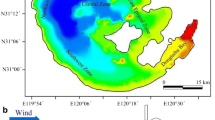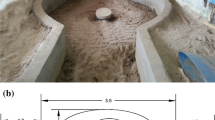Abstract
Purpose
Coherent motion plays a significant role in sediment resuspension, which is an important cause of eutrophication in Lake Taihu. The most popular approach in detecting coherent motion in wall turbulence is quadrant splitting. However, an important threshold parameter (H) is set by empiricism during inspection above which burst event occurs. This study is aimed at eliminating the erroneous detection caused by this empirical parameter in identifying coherent motions, giving an objective range of H for Lake Taihu and then illustrating the interactions between coherent motion and sediment resuspension.
Materials and methods
Based on in situ monitoring with Acoustic Doppler Velocimetry (ADV) and Optical Backscatter Sensor (OBS), high-frequency data of three-dimensional velocities and suspended sediment concentration at the bottom of Lake Taihu were obtained. Autocorrelation function and quadrant splitting were jointly adopted to determine parameter H without any empiricism.
Results and discussion
The value of parameter H varied from 0.72 to 1.28 in Lake Taihu, and an increase of 0.56 in H value led to decreases of 10.7–24.1% in the stress fraction and 14.7–26.5% in the sediment flux fraction. At the Central Zone site, the dominant motions were ejection and sweep, while inward and outward interactions dominated the exchange processes at the East Bay site. Only 16.8, 14.3, and 17.0% of the time fractions of coherent motions contributed up to 58.3, 74.5, and 55.0% to the sediment flux fractions at different observation sites, and the larger time fractions of burst events contributed less to sediment flux fractions due to the less effect from wind waves and the lack of upwelling currents.
Conclusions
Burst events with large amplitude and short duration contributed significantly to the processes of sediment exchanges. Calculation results of momentum and sediment resuspension fluxes are very sensitive to parameter H, taking one fixed empirical value for H is unsuitable for Lake Taihu. These findings will provide a useful reference for identifying coherent motions precisely and understanding the interactions between coherent motion and sediment resuspension in Lake Taihu.






Similar content being viewed by others
References
Balachandar R, Bhuiyan F (2007) Higher-order moments of velocity fluctuations in an open-channel flow with large bottom roughness. J Hydraul Eng 133:77–87
Blackwelder RF, Kaplan RE (1976) On the wall structure of the turbulent boundary layer. J Fluid Mech 76:89–112
Bogard DG, Tiederman WG (1986) Burst detection with single-point velocity measurements. J Fluid Mech 162:389–413
Cao Z (1997) Turbulent bursting-based sediment entrainment function. J Hydraul Eng 123:233–236
Carrick HJ, Aldridge FJ, Schelske CL (1993) Wind influences phytoplankton biomass and composition in a shallow, productive lake. Limnol Oceanogr 38:1179–1192
Cellino M, Lemmin U (2004) Influence of coherent flow structures on the dynamics of suspended sediment transport in open-channel flow. J Hydraul Eng 130:1077–1088
Chen D, Sun HG, Zhang Y (2013) Fractional dispersion equation for sediment suspension. J Hydrol 491:13–22
Conley DJ, Paerl HW, Howarth RW, Boesch DF, Seitzinger SP, Havens KE, Lancelot C, Likens GE (2009) Controlling eutrophication by reducing both nitrogen and phosphorus. Science 323:1014–1015
Duan J, He L, Wang GQ, Fu XD, Palmer RN (2011) Turbulent burst around experimental spur dike. Int J Sediment Res 26:471–486
Grass AJ (1971) Structural features of turbulent flow over smooth and rough boundaries. J Fluid Mech 50:233–255
Guard PA, Nielsen P, Baldock TE (2011) Bed shear stress in unsteady flow. Coast Eng Proc 1:8
Heathershaw AD (1974) "bursting" phenomena in the sea. Nature 248:394–395
Heathershaw AD, Thorne PD (1985) Sea-bed noises reveal role of turbulent bursting phenomenon in sediment transport by tidal currents. Nature 316:339–342
Hoeg S, Kohler J (2000) Phytoplankton selection in a river-lake system during two decades of changing nutrient supply. Hydrobiologia 424:13–24
Hou J, Wang C, Wang P, Qian J (2013) Temporal variability and spatial distribution of granulometric composition of surface sediments and classification in Taihu Lake. J Hohai University (Nat Sci) 41:114–119 (in Chinese)
Huang ZF, Zhou H, Luo JS (2007) The investigation of coherent structures in the wall region of a supersonic turbulent boundary layer based on DNS database. Sci China Ser G 50:348–356
Hurther D, Lemmin U (2000) Shear stress statistics and wall similarity analysis in turbulent boundary layers using a high-resolution 3-D ADVP. IEEE J Ocean Eng 25:446–457
Jackson RG (1976) Sedimentological and fluid-dynamic implications of the turbulent bursting phenomenon in geophysical flows. J Fluid Mech 77:531–560
Jain RK, Kumar A, Kothyari UC (2015) Turbulence statistics of flow through degraded channel bed of sand–gravel mixture. J Hydro-Environ Res 9:508–518
Jiang N, Wang Z (1995) Detection of average burst period in wall turbulence by means of autocorrelation. J Exp Mech 10:343–348 (in Chinese)
Kassem H, Thompson CEL, Amos CL, Townend IH (2015) Wave-induced coherent turbulence structures and sediment resuspension in the nearshore of a prototype-scale sandy barrier beach. Cont Shelf Res 109:78–94
Katul G, Kuhn G, Schieldge J, Hsieh CI (1997) The ejection-sweep character of scalar fluxes in the unstable surface layer. Bound-Layer Meteorol 83:1–26
Kawanisi K, Yokosi S (1993) Measurements of turbulence and suspended sediment in Tidal River. J Hydraul Eng 119:704–724
Keylock CJ (2007) The visualization of turbulence data using a wavelet-based method. Earth Surf Proc Land 32:637–647
Keylock CJ (2008) A criterion for delimiting active periods within turbulent flows. Geophys Res Lett 35:85–90
Keylock CJ, Lane SN, Richards KS (2014) Quadrant/octant sequencing and the role of coherent structures in bed load sediment entrainment. J Geophys Res Earth Surf 119:264–286
Kim HT, Kline SJ, Reynolds WC (1971) The production of turbulence near a smooth wall in a turbulent boundary layer. J Fluid Mech 50:133–160
Kong F, Hu W, Gu X, Yang G, Fan C, Chen K (2007) On the cause of cyanophyta bloom and pollution in water intake area and emergency measures in Meiliang Bay, Lake Taihu in 2007. J Lake Sci 19:357–358 (in Chinese)
Li Y, Tang C, Wang J, Acharya K, Du W, Gao X et al (2017) Effect of wave-current interactions on sediment resuspension in large shallow Lake Taihu, China. Environ Sci Pollut Res 24:4029–4039
Liu X, Bai Y (2014) Turbulent structure and bursting process in multi-bend meander channel. J Hydrodyn 26:207–215
Liu X, Zhang Y, Yin Y, Wang M, Qin B (2013) Wind and submerged aquatic vegetation influence bio-optical properties in large shallow Lake Taihu, China. J Geophys Res 118:713–727
Luchik TS, Tiederman WG (2006) Timescale and structure of ejections and bursts in turbulent channel flows. J Fluid Mech 174:529–552
Lürling M, Van OF (2013) Controlling eutrophication by combined bloom precipitation and sediment phosphorus inactivation. Water Res 47:6527–6537
Mao Y, Yang H, Yuan X, Ji Q (2002) Characteristics of turbulent bursting phenomenon in open channel with a flat and smooth bottom. J Hydrodyn 17:413–421 (in Chinese)
Mohajeri SH, Righetti M, Wharton G, Romano GP (2016) On the structure of turbulent gravel bed flow: implications for sediment transport. Adv Water Resour 92:90–104
Nelson JM, Shreve RL, Mclean SR, Drake TG (1995) Role of near-bed turbulence structure in bed load transport and bed form mechanics. Water Resour Res 31:2071–2086
Nino Y, Garcia MH (1996) Experiments on particle-turbulence interactions in the near-wall region of an open channel flow: implications for sediment transport. J Fluid Mech 326:285–319
Nixdorf B, Deneke R (1997) Why “very shallow” lakes are more successful opposing reduced nutrients loads. Hydrobiologia 342(343):269–284
Noguchi K, Nezu I (2009) Particle-turbulence interaction and local particle concentration in sediment-laden open-channel flows. J Hydro-Environ Res 3:54–68
Offen GR, Kline SJ (1974) Combined dye-streak and hydrogen-bubble visual observations of a turbulent boundary layer. J Fluid Mech 62:223–239
Offen GR, Kline SJ (1975) A proposed model of the bursting process in turbulent boundary layers. J Fluid Mech 70:209–228
Paerl HW, Huisman J (2008) Blooms like it hot. Science 320:57–58
Pang CC, Wang FF, Wu SQ, Lai XJ (2015) Impact of submerged herbaceous vegetation on wind-induced current in shallow water. Ecol Eng 81:387–394
Papanicolaou AN, Diplas P, Dancey CL, Balakrishnan M (2001) Surface roughness effects in near-bed turbulence: implications to sediment entrainment. J Eng Mech 127:211–218
Qin B (2009) Lake eutrophication: control countermeasures and recycling exploitation. Ecol Eng 35:1569–1573
Qin B, Hu W, Gao G (2004) Dynamics of sediment resuspension and the conceptual schema of nutrient release in the large shallow Lake Taihu, China. Chin Sci Bull 49:54–64
Qin B, Zhu G, Zhang L, Luo L, Gao G, Gu B (2006) Estimation of internal nutrient release in large shallow Lake Taihu, China. Sci China Ser D 49:38–50
Qin B, Xu P, Wu Q, Luo L, Zhang Y (2007) Environmental issues of Lake Taihu, China. Hydrobiologia 581:3–14
Ren H, Wu Y (2011) Turbulent boundary layers over smooth and rough forward-facing steps. Phys Fluids 23:21
Shu W, Tang N (1988) Busrt frequeney in turbulent boundary layers. Acta Mech Sinica-Prc 4:291–303
Sondergaard M, Kristensen P, Jeppesen E (1992) Phosphorus release from resuspended sediment in the shallow and wind-exposed Lake Arreso, Denmark. Hydrobiologia 228:91–99
Stone R (2011) China aims to turn tide against toxic lake pollution. Science 333:1210–1211
Strom KB, Papanicolaou AN (2007) ADV measurements around a cluster microform in a shallow mountain stream. J Hydraul Eng 133:1379–1389
Sumer BM, Deigaard R (1981) Particle motions near the bottom in turbulent flow in an open channel. J Fluid Mech 109:311–337
Sumer BM, Oguz B (1978) Particle motions near the bottom in turbulent flow in an open channel. J Fluid Mech 86:109–127
Thompson CEL, Kassem H, Williams JJ (2013) BARDEX II: nearshore sediment resuspension and bed morphology. J Coast Res SI 65:1593–1598
Tubergen RG, Tiederman WG (1993) Evaluation of ejection detection schemes in turbulent wall flows. Exp Fluids 15:255–262
Voulgaris G, Meyers ST (2004) Temporal variability of hydrodynamics, sediment concentration and sediment settling velocity in a tidal creek. Cont Shelf Res 24:1659–1683
Wang D (2000) On the spatial structure of low-speed streaks and particle motion in the wall region of turbulent open channel flow. Tsinghua University, Dissertation (in Chinese)
Willmarth WW, Lu SS (1972) Structure of the Reynolds stress near the wall. J Fluid Mech 55:65–92
Wu F, Yang K (2004) Entrainment probabilities of mixed-size sediment incorporating near-bed coherent flow structures. J Hydraul Eng 130:1187–1197
Wu T, Qin B, Zhu G, Zhu M, Wei L, Luan C (2013) Modeling of turbidity dynamics caused by wind-induced waves and current in the Taihu Lake. Int J Sediment Res 28:139–148
Wu T, Qin B, Brookes JD, Shi K, Zhu G, Zhu M, Yan W, Wang Z (2015) The influence of changes in wind patterns on the areal extension of surface cyanobacterial blooms in a large shallow lake in China. Sci Total Environ 518-519:24–30
Wu T, Timo H, Qin B, Zhu G, Janne R, Yan W (2016) In-situ erosion of cohesive sediment in a large shallow lake experiencing long-term decline in wind speed. J Hydrol 539:254–264
Yuan Y, Wei H, Zhao L, Cao Y (2009) Implications of intermittent turbulent bursts for sediment resuspension in a coastal bottom boundary layer: a field study in the western Yellow Sea, China. Mar Geol 263:87–96
Zhu M, Zhu G, Zhao L, Yao X, Zhang Y, Gao G, Qin B (2013) Influence of algal bloom degradation on nutrient release at the sediment-water interface in Lake Taihu, China. Environ Sci Pollut Res 20:1803–1811
Funding
The research was supported by National Science Funds for Creative Research Groups of China (No. 51421006); National Key Research and Development Plan (2016YFC0401703, 2017YFC0405203), and Chinese National Science Foundation (51779072, 51579071, 41323001, 51539003); the program of Dual Innovative Talents Plan and Innovative Research Team in Jiangsu Province; Postgraduate Research & Practice Innovation Program of Jiangsu Province; the Priority Academic Program Development of Jiangsu Higher Education Institutions, and the Fundamental Research Funds for the Central Universities.
Author information
Authors and Affiliations
Corresponding author
Additional information
Responsible editor: Shiming Ding
Rights and permissions
About this article
Cite this article
Wei, J., Li, Y., Weng, S. et al. Determination of threshold parameter in quadrant splitting for identifying coherent motions in Lake Taihu, China. J Soils Sediments 19, 1017–1028 (2019). https://doi.org/10.1007/s11368-018-2099-8
Received:
Accepted:
Published:
Issue Date:
DOI: https://doi.org/10.1007/s11368-018-2099-8




